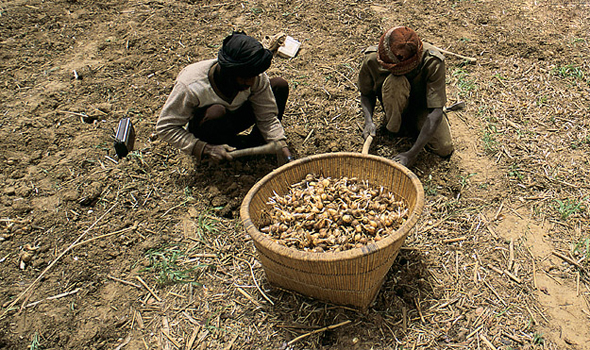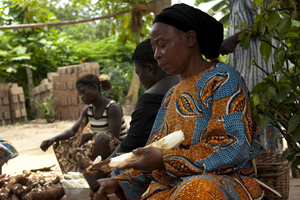Research Brief
An Assessment of a Village Development Programme in Mozambique
- The programme did lead participating households to use improved seeds.
- Food consumption scores did not improve after the programme. However during the programme participating households moved to more sustainable strategies to cope with food shortages.
- Fertilizer use improved by 20 per cent amongst programme participants.
- The effectiveness of the programme on farming outcome declined in the second year. (NPS point out that this may be partly due to a drought which hit participating villages harder than those in the control group, as well as delays in delivering the aid).
The crucial role of agriculture in the sustainable development of sub-Saharan Africa is now widely recognized. Mozambique is an illustrative of why growth in this sector is so important. Despite many years of high GDP growth rates the number of people living in poverty has not declined at all. The key reason for this is that 80 per cent of the population is dependent on agriculture for their living, and productivity in this sector has hardly improved at all during the recent years of high GDP growth. One potential method for remedying this situation is group-based interventions; this brief looks one such programme and assesses what success it has had in promoting agricultural development.

How does the intervention work?
The agricultural intervention is part of the Lutheran World Foundation (LWF) village development programme set up in June 2008. The intervention focuses on several small villages in the Gaza region of Mozambique, and aims to improve the lives and welfare of the villagers, particularly women. Poor, uneducated women are often in a particularly vulnerable situation and may lack sufficient resources and capacity to benefit from new techniques. This intervention aims to remedy that situation by improving local community support structures and enhancing community capacity.
 In the case of agriculture this attempt at capacity building entails the creation of farmer groups, training, and the setting up of demonstration farms for facilitating technology transfers. The government and the LWF provide the farmers with seeds, fertilizers, training, and small amounts of equipment such as axes, hoes and rakes. What is different about this project compared to other similar ones is that it is a group-based project which takes place on a joint plot and attempts to foster a community approach to improving farming technology.
In the case of agriculture this attempt at capacity building entails the creation of farmer groups, training, and the setting up of demonstration farms for facilitating technology transfers. The government and the LWF provide the farmers with seeds, fertilizers, training, and small amounts of equipment such as axes, hoes and rakes. What is different about this project compared to other similar ones is that it is a group-based project which takes place on a joint plot and attempts to foster a community approach to improving farming technology.
As farmers in Africa typically, and historically around the world, keep some of the yield from their harvests to use as seeds for the next season’s crop, the project is expected to eventually become self-sustainable. But, it is naturally possible that farmers may experience some type of catastrophe and have to consume their whole seed stock one year, and as such continued assistance at some level may help to remove uncertainty and help speed up recovery in case of external shocks.
Has the intervention been successful?
 It is important to find out both what has been the effect of the project on farming strategies and the amount of crops harvested, as well as how has the village’s food security situation developed since the beginning of the intervention and how they cope with food shortages. To acquire the data necessary to make these judgments the authors conducted extensive household surveys in six small villages, four of which were used as control groups, before and after the intervention. Residents were asked about their general living conditions and about factors directly relevant to the success of the project, such as uptake of the programme, food intake, and strategies for coping with food shortages.
It is important to find out both what has been the effect of the project on farming strategies and the amount of crops harvested, as well as how has the village’s food security situation developed since the beginning of the intervention and how they cope with food shortages. To acquire the data necessary to make these judgments the authors conducted extensive household surveys in six small villages, four of which were used as control groups, before and after the intervention. Residents were asked about their general living conditions and about factors directly relevant to the success of the project, such as uptake of the programme, food intake, and strategies for coping with food shortages.
Using the household survey data the following findings were generated:
- Fertilizer use improved by 20 per cent amongst programme participants.
- The programme did lead participating households to use improved seeds.
- Food consumption scores did not improve after the programme. However during the programme participating households moved to more sustainable strategies to cope with food shortages.
- The effectiveness of the programme on farming outcome declined in the second year. (NPS point out that this may be partly due to a drought which hit participating villages harder than those in the control group, as well as delays in delivering the aid).
- Permanent improvements in the livelihoods of those living in adverse conditions require a long-term and constant form of aid.
The decline in effectiveness after a year, due to drought and delays in aid, shows that if permanent improvements in the livelihoods of those living in adverse conditions are to be achieved, constant and long-term view and practice of aid is required.
 Join the network
Join the network